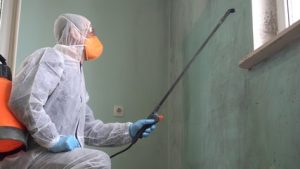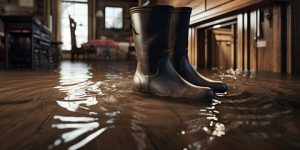Mold Removal Salt Lake City refers to the physical elimination of visible mold growth on non-porous surfaces. It may not address the underlying moisture encouraging mold growth, so it’s important to follow through with remediation measures for a long-term solution.

Mold can cause serious health problems if not removed promptly, including mycotoxicosis and other respiratory issues. It can also damage the infrastructure of a property.
Mold growth is a serious health problem that can spread easily throughout the home. It can cause respiratory problems, skin irritation, and more. It also can damage the surface of walls and furniture. Fortunately, there are ways to prevent and treat mold. Taking preventive measures, fixing leaks promptly, and keeping the house properly ventilated are all important. In addition, removing any existing mold can help keep it from returning.
Many household products can be used to remove or kill mold, including bleach and hydrogen peroxide. Both are effective, but each has its pros and cons. Bleach is a strong chemical that can damage surfaces, while hydrogen peroxide is less likely to harm them.
Another good option is vinegar, which is a common ingredient in most kitchens. It can be diluted with water or used in its pure form to kill mold. Vinegar can be applied directly to the affected area and left to sit for a few hours. Then, the area can be scrubbed and rinsed. This method is especially effective on non-porous surfaces.
Other effective home solutions for killing and preventing mold include tea tree oil, borax, and baking soda. These natural ingredients are also available at a low price and can be used in place of bleach and other harmful chemicals. The key is to use these cleaning agents regularly to prevent the recurrence of mold.
If you find that you are having trouble removing or preventing mold, it is best to consult a professional. These experts can provide the tools and techniques you need to permanently eradicate mold and mildew. They can also give you tips on how to keep mold and mildew from returning.
To remove or kill mold, mix one part hydrogen peroxide (3% solution) with two parts baking soda to create a paste. Apply this to the moldy area and let it sit for 30 minutes. Then, scrub the area with a nylon-bristled brush and rinse it. Ensure that you work in a well-ventilated area to avoid inhaling the fumes from the cleaning agent. It is also a good idea to wear rubber gloves and eye protection to protect yourself from the harsh chemicals.
Distilled White Vinegar
White distilled vinegar is a powerful cleaning product that can kill many different mold species. It’s a good choice for most surfaces, though it should not be used on natural, unsealed stone or metal, which could be damaged by its acidic content. It can also damage some paints, especially oil-based ones. For these surfaces, a full-strength fungicide is necessary to prevent lasting damage.
Vinegar has a strong odor when it is used at full strength, which may be a turn-off for some people. If you plan to use it, open a window or two to help with ventilation. It can also be a good idea to wear rubber gloves and a face mask to protect yourself from irritation. If you do decide to use this product, mix it in a 1:1 ratio with water before applying it to the affected area.
The best way to apply the solution is to use a spray bottle. Spray generously over the entire moldy surface, and allow it to sit for about an hour. Then, scrub the area and rinse it with clean water. Repeat the process if necessary.
If there are still visible stains, it may be necessary to treat the area with a bit of baking soda mixed with water. This will help remove any residual staining from the wall and prevent it from returning in the future.
When working with any type of cleaning product, it’s a good idea to take safety precautions. When dealing with a strong cleaner such as vinegar, you should always wear protective gloves, a mask and eye protection. Additionally, you should make sure that the air is well-ventilated by opening windows and doors and running exhaust fans. Finally, it’s a good idea to have a plastic drop cloth or trash bag beneath your work area to catch any debris and spores. When you’re finished, simply ball up the cloth or trash bag and place it in a trash can outdoors for disposal. This is a vital step to help ensure that you don’t accidentally inhale any of the mold spores.
Lemon Juice
Lemons are a natural cleaning powerhouse with a wide variety of uses. They are good for stain removal and deodorizing, but they also have great antiseptic and disinfectant properties that make them effective for tackling mold. To use lemon juice for mold removal, mix it with water and apply the solution to the affected surface. Leave it to soak in for about an hour before scrubbing and rinsing.
Lemon juice is also a great way to brighten whites and remove rust and mildew stains from clothing and fabric. It works similarly to bleach, but without the harmful chemicals. Lemon juice can be applied directly to the stained area or added to a homemade laundry detergent to help lift dirt and stains in the wash cycle.
In addition to using lemon juice to combat mildew and mold, it can be used to fight soap scum and hard water deposits on surfaces in your home. It can be applied directly to the affected surface, or mixed with baking soda and vinegar to create a DIY scrubbing paste. Scrub the paste into the affected surface, rinse and wipe dry.
Although hydrogen peroxide at 3% concentration is the most effective solution for killing mold spores, it can be toxic to humans and pets. Vinegar, on the other hand, has a lower pH level and can be safely used for cleaning and disinfecting surfaces.
Other natural solutions, such as tea tree oil and grapefruit seed extract, are also effective at eliminating mold. The former is a powerful antifungal agent that can be used to spray and scrub moldy surfaces. The latter is a nontoxic fungicide with a low recurrence rate when applied to nonporous surfaces.
To use either of these natural fungicides, simply add ten drops of grapefruit seed extract or tea tree oil to one cup of water. Stir well and apply to the affected area with a clean cloth or sponge. Repeat as necessary until the mold is gone. These natural, nontoxic, and inexpensive solutions are the perfect addition to your eco-friendly cleaning arsenal. Not only are they safe for most surfaces, but they also smell fresh and clean.
Baking Soda
Baking soda is a natural, effective and inexpensive cleaning agent that can be used to remove mold. It is nontoxic and safe for kids and pets, and unlike chemical cleaners, it does not contain harsh chemicals that can damage surfaces or materials. According to the National Library of Medicine, baking soda kills most types of mold on contact and prevents future growth by unbalancing the pH levels of the affected surface. It also helps eliminate odors and absorbs moisture. To use baking soda, mix it with water and spray the solution onto the affected surface. Alternatively, you can sprinkle it directly onto the mold and let it sit for a few hours before wiping it away.
It is important to note that baking soda is most effective on nonporous surfaces, such as glass or tile. Porous surfaces such as drywall and concrete are more difficult to clean thoroughly. If you are trying to get rid of mold in porous surfaces, it is a good idea to follow up with hydrogen peroxide or diluted white vinegar.
Both baking soda and hydrogen peroxide work well on removing surface mold, but they are not the best solution for large-scale mold problems or more dangerous species of mold, such as black mold. If you are battling serious issues with mold, it is a good idea to call a professional for a thorough mold remediation.
Before using any of these cleaners, it is important to wear safety equipment, including masks and gloves. It is also a good idea to open windows and doors during the cleaning process to allow fresh air to circulate throughout the room. In addition, make sure that children and pets are not in the area while you are cleaning to avoid accidental exposure to the chemicals. Lastly, be sure to rinse and dry the area completely after cleaning to ensure that there is no residual cleaning solution left behind, which could cause further mold growth. It is also a good idea to dispose of any used cleaning supplies and gloves in a sealed trash bag.








